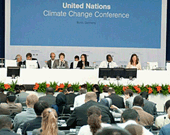Poor countries work harder than rich ones to reduce carbon emissions
Published on Fri, 2011-06-17 09:49
Sources Experts and activists warned this week in Bonn, where another UN conference on climate change took place, that the talks are following dangerous paths. Developing countries are working harder than the rich nations to reduce their carbon emissions, said senior scientist Sivan Kartha, while 125 organizations from all continents urged the governments to renew their commitment to the current international moratorium on geoengineering. “We agreed in Bali in Dec 2007 to build a much stronger international climate regime to better cope with recent alarming analysis of the disastrous effects of climate change. But instead of achieving this new regime, we now see quite unbelievably an attempt to dismantle even the weaker regime that we now have,” said Martin Khor, Executive Director of the South Centre, an intergovernmental thinktank based in Geneva that provides advice to developing country governments In the same press briefing in Bonn, Kartha, of the Stockholm Environment Institute (SEI), revealed new figures that showed developing countries were taking much greater efforts to reduce their climate pollution than developed countries. “Instead of a legally binding system to lock in adequate emissions cuts to 2020 for developed countries collectively and individually --which is what was agreed to-- there is now the most likely prospect of a ‘voluntary pledge’ system in which developed countries merely state what they can do, without a formal system of assessing the adequacy of each country's target or the adequacy of the collective effort. This will itself be a disincentive for developing countries, when they see those who are supposed to lead the process, falter instead.” Khor said. “Despite this, the several studies analyzed here show that under all of the scenarios on current pledges developing countries have pledged to reduce more gigatonnes [of emissions] in total than developed countries. Of greatest concern is that if the accounting loopholes are not closed off, developed countries could use them to be in technical compliance with even the upper estimates of their pledges, while their emissions are actually growing between now and 2020, and possibly even beyond,” Kartha added. “There’s a false perception that we need to focus primarily on increasing ambition from emerging economies –these economies have put serious emission cuts on the table. It’s the developed countries that need to actually reduce their emissions, and increase their commitment to provide finance and technology that will allow even greater reductions in developing countries, if we are to have any hope of keeping to a pathway that limits temperature rise to 1.5C or 2C,” the scientist said. Take geoengineering off the table In the meantime, 125 international and national organisations, representing at least 40 countries from all continents, sent an open letter to the Intergovernmental Panel on Climate Change (IPCC), demanding a clear statement of its commitment to precaution and to the current international moratorium on geoengineering. The IPCC will hold an expert meeting on geoengineering next week in Lima, Peru. Geoengineering is the deliberate manipulation of Earth systems to alter the climate, including high-risk technologies such as blasting particles into the stratosphere to mimic volcanic eruptions (to block sunlight) and “fertilizing” oceans to grow plankton blooms for carbon sequestration. Formerly in the realm of science fiction, geoengineering has been gaining ground as a possible response to the climate crisis, the organisations argued in a press release. In October 2010, the UN Convention on Biological Diversity established a moratorium on geoengineering. Nonetheless, Christiana Figueres, the Executive Secretary of the UN Framework Convention on Climate Change (UNFCCC), told The Guardian last week that “we are putting ourselves in a scenario where we will have to develop more powerful technologies to capture emissions out of the atmosphere,” referring to geoengineering techniques. Meenakshi Raman, from Third World Network-Malaysia that signed the letter to the IPCC, argued that “it is completely misguided for Ms. Figueres to suggest that we work on sucking carbon out of the atmosphere rather than stop putting it in; it is equally misguided for the IPCC to assume that geoengineering has any place at all in what they call the ‘portfolio of response options’ to climate change.” "This is not a scientific question; it’s a political one," Raman added. The U.S. and UK governments appear especially open to the prospect of geoengineering, which is no surprise, according to Silvia Ribeiro of the ETC Group. “It’s a convenient way for Northern governments to dodge their commitments to emissions reduction.” Ribeiro continues, “But the climate is a complex system; manipulating climate in one place could have grave environmental, social and economic impacts on countries and peoples that had no say on the issue. Scientists estimate that blasting particles into the stratosphere could alter monsoon and wind patterns and put at risk the food and water sources for 2 billion people.” “As the world watched the Australian airline industry thrown into chaos this week by volcanic ashes drifting from Chile, it’s absurd that the IPCC is considering how to do the same thing on purpose,” said Ricardo Navarro, of Cesta and Friends of the Earth International, detained in Buenos Aires due to the volcanic ash. La Via Campesina, the world’s largest small-scale farmers network, is concerned that the impacts of climate manipulation on agriculture would be felt particularly by peasants in the South and that tinkering with the oceans could destroy the livelihoods of thousands of small fishermen. “Geoengineering is a false solution to climate change and so dangerous to nature and to the world’s people, it should be banned,” argued the group. |
SUSCRIBE TO OUR NEWSLETTER



